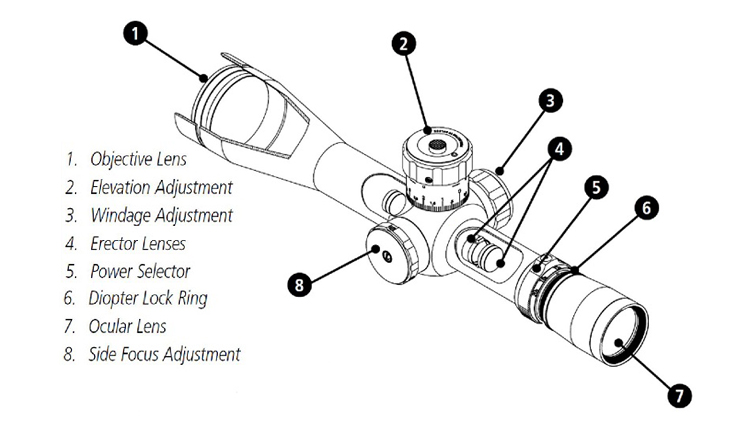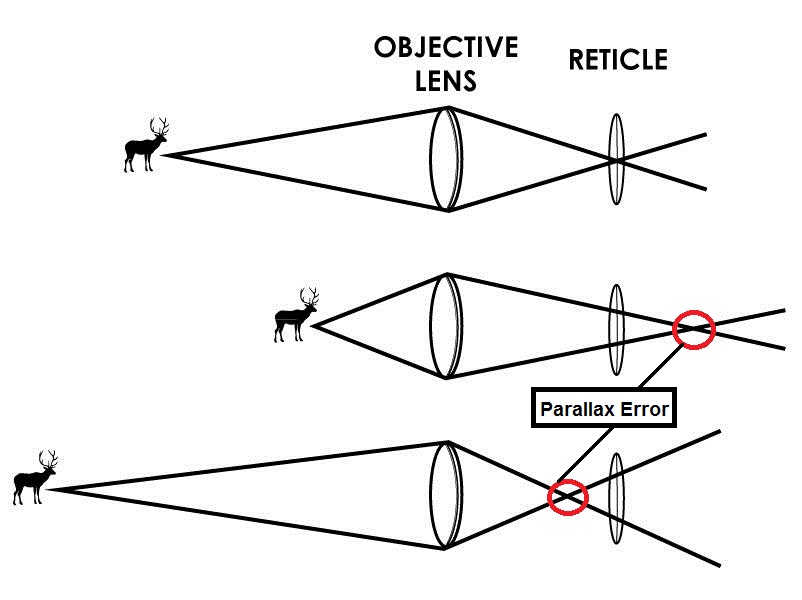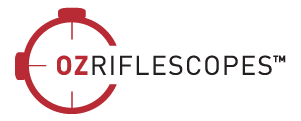
About Riflescope
Riflescopes come in a variety of different types for a large range of uses and situations. There are many features which will help you choose what scope you need including magnification, aperture, reticles and adjustments. Here is an image of the parts of your riflescope to help you understand the different elements of your riflescope.

Understanding the Numbers
The name of a riflescope generally contains 3 numbers. Let’s take the riflescope Vortex Diamondback 3-9x40 Riflescope for example. The first two numbers are the variable magnification of the riflescope. In this case it is 3x through to 9x. Magnifications can be as low as 1x through to 23x or higher. Sometimes you can get a single magnification. The Nikon Buckmasters 4x40 Matte Nikoplex Riflescope however is an example of where magnification is fixed on the rifle scope.
The last number in the title relates to the mm’s of the objective lens. The objective lens is the diameter lens on the front of the scope. This lens allows light to pass through the scope to your eye. The larger the objective lens, the more light that can get to your eye making the quality of the image brighter. The larger lens can be particularly beneficial to people hunting at dawn or dusk in low light conditions.
Windage and Elevation Adjustments
Every scopes are equipped with adjustment knobs for windage (lateral), elevation (up and down) and focus for individual user's aim. Most of the long-range scopes have adjustments for parallax. These adjustments are controlled by dials or knobs, located on the adjustment turret, which are present along the scope. These adjustment dials are made up of a system of tiny, fragile components in the scope help to alter the crosshair positions, which eventually sets the bullet's target aim. Most scope adjustments were claimed to be calibrated at 1/4 inch per click at 100 yards. The windage and elevation adjustments usually come with 'clicking' sounds.
Making these adjustment will move the entire reticle in the rifle scope to allow for accuracy. In order to attain the best focus for a rifle scope reticle, aim the scope and slowly turn the ocular-lens bell until the reticle appears sharp. Once the reticle focus has been set, lock the ocular-lens bell in place to secure the perfect aiming sight. There are two different scales used when measuring the reticle location to compensate for the bullet trajectory drop, these are minute-of-angle (MOA) and milliradian (MRAD):-
Parallax Adjustments
Some riflescopes come with a Parallax Adjustment (PA) or Adjustable Objective (AO). Parallax occurs when the reticle moves off line with the target whenever your eye moves around the lens. Scopes with high magnification, or long-range shooting scopes, where even slight sighting errors can cause major issues, should be equipped with a parallax adjustment. This adjustment of the objective lens ensures the target is brought in the exact focal plane of the reticle at any given distance. Manual reticle adjustment is vital to obtain the perfect aim sight through parallax adjustment. If the focused distance is incorrectly set, the targeted sight will be off from the actual target, eventually resulting in parallax error and missed shot. Tactical riflescopes do not generally have a parallax adjustment because the range of the target can never be guessed. Lower magnification scopes do not require a parallax adjustment either as at low powers the amount of parallax too small to have any importance to be practical. Here is an example of what parallax will do:

Eye Relief
The distance between the eyepiece lens and the position in which the eye must be placed to see through the scope. Eye-relief is especially important for two different reasons. Firstly, it is important to provide a decent field of view for people who wear eyeglasses. Secondly, you need enough eye relief to provide an “air cushion” to protect the eye from recoil. To establish proper eye relief you need to ensure that the following steps are followed when mounting your rifle scope:
- With the scope in the mounts as far forward as possible, hold the rifle in your normal stance. Scopes should be magnified as high as possible for this process.
- Move the scope slowly toward the rear of the mount until you can see the full field-of-view.
- This is the place you need to position your scope to achieve maximum eye relief.
- Complete the installation.











